Abstract
The purpose of this study was to explore the regulation of BcMYB44 on anthocyanin synthesis and drought tolerance of non-heading Chinese cabbage. The BcMYB44 gene was cloned from the purple inbred line ‘NJZX1-3’ and its green mutant ‘NJZX1-0’. Sequence analysis confirmed that BcMYB44 belongs to the R2R3-MYB family and has the highest homology with BnMYB44. Subcellular localization revealed that BcMYB44 is a nuclear protein. Yeast two-hybrid (Y2H) and Bimolecular Fluorescent Complimentary (BiFC) experiments showed that BcMYB44 interacts with BcPAP1 and BcEGL3. Pigment detection of BcPAP1 and BcMYB44 protein activity in N. benthamiana indicates that BcMYB44 plays a negative regulatory role by inhibiting the expression of key structural genes (F3H, DFR, etc.) in anthocyanin synthesis. Virus-induced gene silencing (VIGS) further confirmed this inhibition. Analysis of drought tolerance of non-heading Chinese cabbage based on VIGS showed that pTY-S plants are more resistant to drought than pTY-BcMYB44 plants. The results indicate that BcMYB44 has a positive regulatory role in drought stress, which most likely is achieved by inhibiting anthocyanin accumulation, regulating stomatal movement, and improving osmotic regulation and homeostasis of reactive oxygen species (ROS).
1. Introduction
Non-heading Chinese cabbage (Brassica campestris ssp. chinensis Makino) is a subspecies of the Brassicaceae family. It originated in China and is an important leafy vegetable cultivated worldwide [1]. Leaf colors of non-heading Chinese cabbage are mainly divided into green, yellow and purple, of which the green leaf cultivar is most common [2]. The change of relative content of chlorophyll, carotenoids, and anthocyanins in leaves directly causes leaf discoloration. Green or yellow leaves are mainly determined by the content of chlorophyll and carotenoids [3], while purple leaves are caused by anthocyanin accumulation, which is affected by the plant’s internal genetic factors, external environment, leaf cell microstructure, physiological and biochemical metabolism level et al. [4]. Anthocyanins are water-soluble pigments and cannot exist stably under natural conditions. They often combine with one or more glycosides to form cyanine glycosides. Anthocyanins have great benefits for the prevention and management of cardiometabolic diseases, such as significant improvement in blood sugar and blood lipid control [5].
As one of the largest gene families, MYB transcription factors (TFs) play important roles in plant growth, cell morphology and pattern construction, metabolic reactions, and are also key regulators in the synthesis of phenylpropane compounds [6,7]. The MYB domains can be divided into four categories: R1-MYB, R2R3-MYB, R1R2R3-MYB and 4R-MYB. According to the C-terminal amino acid sequence of the R2R3-MYB protein, the R2R3-MYB protein is further subdivided into 22 subgroups, among which the fourth subgroup is mostly represented as transcriptional repressors. Their overexpression results in the suppressed expression of related structural genes in the phenylpropane metabolic pathway, thereby hindering the synthesis of flavonoids, lignin, and anthocyanins [8]. For example, GbMYBF2 in Ginkgo biloba [9] and GmMYBZ2 in soybean [10] were both negative regulators of flavonoids synthesis. The MYB44 gene has also been proven to be a negative transcription factor in anthocyanin biosynthesis in many species [11,12]. However, the role of BcMYB44 in anthocyanin synthesis in non-heading Chinese cabbage is not clear and needs to be further explored.
On the other hand, some members of the R2R3-MYB family have been shown to be involved in stress responses. The functions of these transcription factors in response to stress were explored as follows. In Arabidopsis thaliana, AtMYB96-overexpressed mutants increased drought tolerance [13], while AtMYB68-deficient mutants had a weaker tolerance to high temperatures [14]. QsMYB1 responded to heat and drought stress in Quercus suber [15]. For the MYB44 TF, related studies speculated that AmMYB44 played an important role in the response to drought and low-temperature stress of Astragalus membranaceus [16]. XsMYB44 played a role in combing drought and heat stress of Xanthoceras sorbifolium by regulating stomatal movement and homeostasis of ROS [17]. In addition, studies showed that under drought conditions, flavonoids (especially anthocyanins) were synthesized in large quantities, and moderate drought would increase the anthocyanin content in rice [18] and purple leaf dwarf cherry [19]. Xiao and other studies have shown that flavonol enrichment under drought stress can improve osmotic regulation ability, and anthocyanins enrichment inhibited stomatal closure, increased water loss, and reduced the drought tolerance of plants [20]. However, the stress response of BcMYB44 in non-heading Chinese cabbage was unclear. The purpose of this study was to investigate whether BcMYB44 responds to anthocyanin synthesis and drought stress simultaneously and the relationship between the two.
In our study, the MYB gene was obtained by homologous cloning from non-heading Chinese cabbage and named BcMYB44. Moreover, the protein information was explored by sequence analysis, and the regulation mechanisms of BcMYB44 on anthocyanin synthesis and drought resistance in non-heading Chinese cabbage were verified by a functional study.
2. Material and Methods
2.1. Plant and Processing Conditions
The materials used in this study were the purple inbred line ‘NJZX1-3’ and its green mutant ‘NJZX1-0’of non-heading Chinese cabbage provided by the Cabbage Systems Biology Laboratory of Nanjing Agricultural University. They were grown in an artificial climate chamber (Light 16 h/24 °C, darkness 8 h/24 °C). Robust and consistent growing materials were selected for gene cloning and VIGS. The drought treatment was to provide the soil with water until the soil quality reached 50% of the water-saturated soil quality, which was recorded as the initial drought value. The drought treatment lasted for 8 d, and sampling was performed every 2 d. The control (CT) was hydrated every 2 d.
2.2. Gene Cloning and Sequence Analysis
We took 0.1 g of fifth-leaf material, extracted leaf RNA by trizol, and used a Prime Script RT Reagent Kit (TaKaRa) to synthesize cDNA. We designed primers (Table S1) based on the sequence of BraMYB44 (http://brassicadb.org/brad/, accessed on 28 December 2020) to clone the full-length CDS (coding sequence) of BcMYB44 by homology cloning. We used BioXM2.7 to search and translate the ORF of BcMYB44. The physicochemical properties and conserved domains of BcMYB44 protein were analyzed using analytical tools in NCBI (https://www.ncbi.nlm.nih.gov/, accessed on 28 December 2020). The online software SMART (http://smart.embl-heidelberg.de, accessed on 28 December 2020) was used for structural domain analysis. The DNAMAN7 program was used for multiple sequence alignment and the MEGA7 program was used to construct a phylogenetic tree.
2.3. Subcellular Localization of BcMYB44
We ligated the BcMYB44 gene to pEASY®-Blunt Cloning Vector (TRANS), and amplified BcMYB44 using the pEASY-BcMYB44 vector plasmid. According to Liu et al. [21], the fluorescent expression vector pRI101-GFP was digested with BamHI/NdeI restriction enzymes, specific primers pRI101-BcMYB44-F/R (Table S1) were designed to amplify BcMYB44 again, and the fusion expression vector pRI101-BcMYB44 was generated by homologous recombination (Vazyme), which was transferred into Agrobacterium GV3101. The infection solution (containing 10 mM MgCl2, 10 mM MES, 150 μM acetosyringone) was suspended to OD600 = 0.8, and stood at room temperature for 3–4 h. The bacterial solution was injected into the abaxial side of the Nicotiana benthamiana (N. benthamiana) leaf blade using a disposable needle-free syringe (1 mL). For the method of injection, refer to Liu et al. [21]. After 60 h, the injected leaf site was cut, placed on a glass slide, observed and imaged under a laser confocal microscope (Zeiss, LSM780, Oberkochen, Germany).
2.4. Y2H Analysis
Referring to the method of Zhu [22], according to the restriction sites EcoRI/BamHI in the pGADT7 and pGBKT7 vector maps, specific primers were synthesized to amplify the BcMYB44, BcPAP1 and BcEGL3 target genes with restriction sites (Table S1). The reclaimed target fragment (YEASEN) was ligated with the vector and transformed in vitro to obtain the pGADT7-BcEGL3, pGADT7-BcPAP1 and pGBKT7-BcMYB44 fusion expression vector. The pGBKT7-BcMYB44 and pGADT7 were co-transformed (Yeast Double Hybrid Kit, TaKaRa) into the yeast strain Y2H Gold. We estimated the transcript activation ability by observing the growth of transformants on mediums lacking different amino acids after 3–4 days. The interaction between them was tested using the same method.
2.5. BiFC Verification
On the basis of previous studies [23], we further performed Bimolecular Fluorescent Complimentary (BiFC) experiments for protein interaction detection. We designed primers (Table S1) to amplify BcMYB44, BcPAP1 and BcEGL3. Then, BcMYB44 was ligated to PFGC-35S-YN173, and BcPAP1 and BcEGL3 were individually ligated to PFGC-35S-YC155 to form fusion expression vectors. They were transferred into Agrobacterium tumefaciens and cultured overnight to obtain Agrobacterium containing the target vector. We injected the isolated or mixed bacteria into the abaxial side of N. benthamiana leaves. The preparations of the infected solution and agroinfiltration method were the same as for the subcellular localization. A Zeiss confocal laser microscope was used to capture images about 60 h later.
2.6. Pigment Detection of BcPAP1 and BcMYB44 Protein Activity
Transient expression of proteins in N. benthamiana leaves by agroinfiltration was used to explore gene function [24]. With reference to the method of subcellular localization, pRI101-BcPAP1 and pRI101-BcMYB44 were injected into the abaxial side of N. benthamiana separately or together with the dip solution. We observed the color change of the injection site within 10–20 days and took pictures by stereo fluorescence microscope (Leica, M165FC, Weztlar, Germany).
2.7. Real-Time Quantitative PCR (RT-qPCR) Analysis
Forward and reverse primers were designed using Primer-BLAST with the online software NCBI, and the actin gene was used as an internal reference (Table S1). The experimental procedure and dosage referred to the instructions of the SYBR Premix Ex Taq TM II (TaKaRa) kit, and the results were calculated by the ΔΔCT method [25]. The procedure was a standard two-step method with 3 biological replicates, and quantitative analysis was performed on a 7500 RT-qPCR machine (Applied Biosystems, Foster, USA).
2.8. VIGS Processing
The virus used in this study was turnip yellow mosaic virus (TYMV). We constructed the virus-induced gene silencing (VIGS) vector pTY-BcMYB44 (Table S1). The plasmid pTY-BcMYB44 was embedded with gold powder and introduced into ‘NJZX1-3’ and ‘NJZX1-0’ at the five-leaf stage using a gene gun (PDS-1000/He, Bio-Rad, California, USA). The plants ‘NJZX1-3’ and ‘NJZX1-0’ into which the pTY empty plasmid (pTY-S) was introduced were used as control. Phenotypic changes in plants were observed after 10–20 days.
2.9. Determination of Physiological Indicators
The method for extracting total anthocyanins and chlorophyll from leaves was improved on the basis of Dong et al.’s method [26]. Key anthocyanin synthesis-related enzyme activity (PAL, CHI, UFGT), MDA content and antioxidant enzyme activity (POD, SOD, CAT) were referred to (Solarbio). We improved the determination method of relative water content and relative conductivity of leaves on the basis of previous research [27]. The measurement of proline used the ninhydrin-sulfosalicylic acid method. Photosynthesis, stomatal conductance, etc. were measured with a portable photosynthetic apparatus (Li-6400, Lincoln, USA). Stomatal images were captured by an upright fluorescence microscope (Leica, DM6B, Germany).
3. Results
3.1. Sequence Analysis of BcMYB44
The online software Expasy analysis showed that the isoelectric point of BcMYB44 protein was 8.34, the molecular weight was 3.26 × 104, and the hydropathic index was -0.552. It was a hydrophilic protein. Conserved domain analysis results showed that MYB44 protein contained two MYB DNA-binding domains and belonged to the R2R3-MYB superfamily (Figure S1). Multiple sequence alignment indicated that they had two MYB domains at the N-terminal (8–50, 60–102 amino acid sites) and the same repressor domain LSLSL, which is outlined in red in Figure 1A. It was shown that the homology of MYB44 in these six species ranged from 83.7% to 99.7%, among which BnMYB44 (Landing number: NP_001302626.1) had the highest homology with BcMYB44. Moreover, MEGA7 was used to construct a molecular phylogenetic tree (Figure 1B) based on the multiple alignments of the protein sequence with the MYB protein sequences of other species.
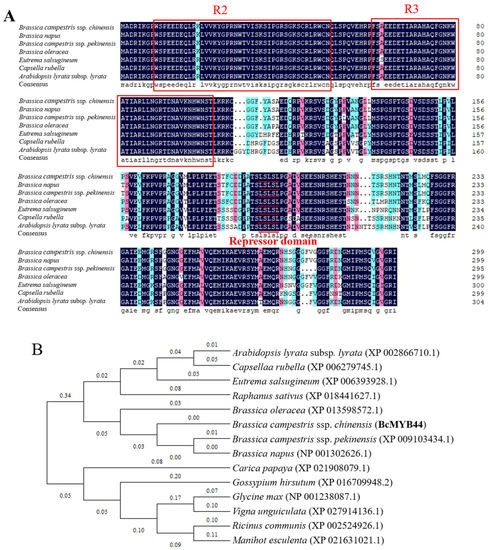
Figure 1.
Sequence Analysis of BcMYB44. (A) The multiple sequence alignment of BcMYB44 protein with MYB44-like proteins in Brassica compestris ssp. chinensis.; Brassica napus.; Brassica compestris ssp. pekinensis.; Brassica oleracea.; Eutrema salsugineum.; Capsela rubella.; Arabidopsis lyrata subsp. lyrata.R2, R3: DNA-binding domains of MYB. (B) Phylogenetic analysis of BcMYB44 protein and MYB TFs proteins in other species (Arabidopsis lyrata subsp. lyrata; Capsella rubella.; Eutrema salsuqineum.; Raphanus sativus.; Brassica oleracea.; Brassica compestris ssp. pekinensis.; Brassica napus., Carica papaya.; Gossypium hirsutum.; Glycine max.; Vigna unguiculata.; Ricinus communis.; Manihot esculenta.).
3.2. Subcellular Localization of BcMYB44
The pRI101-GFP fluorescent expression vector can emit a green fluorescent signal under the GFP channel. The nucleus marker (RFP) was used to mark the position of the nucleus and can emit a clear red fluorescent signal under the RFP channel. We observed the N. benthamiana leaves 60 h after injection. The empty vector pRI101 was expressed in both the nuclear membrane and nucleus, while the pRI101-BcMYB44 fusion vector only overlapped the green and red fluorescence signals at the nucleus (Figure 2). Therefore, BcMYB44 was a nuclear protein.
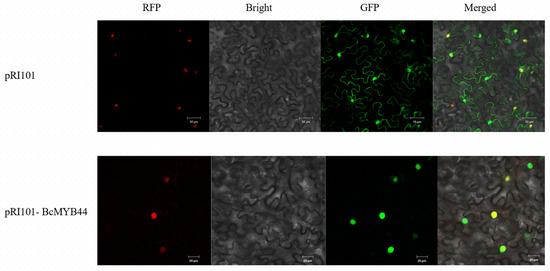
Figure 2.
The subcellular localization of BcMYB44 in N. benthamiana leaf cells. (pRI101 for empty vector localization. Scale bars = 50 µM; pRI101-BcMYB44 for BcMYB44 protein localization. Scale bars = 20 µM.). RFP: red fluorescence signal under RFP-excited; Bright: Bright field; GFP: green fluorescence signal under GFP-excited light; Merged: superposition of RFP, GFP and bright field.
3.3. Interaction between BcMYB44 and BcPAP1 and BcEGL3 In Vitro and Vivo
We streaked the Y2H Gold strain on YPDA plates and incubated serial dilutions (100, 10−1, 10−2, 10−3) at 30 °C for 3–5 d. The negative control (pGADT7 + pGBKT7) did not grow on the SD/-Trp-Leu-His-Ade medium, and the positive control (pGADT7-T + pGBKT7-53) grew well on all three media. The pGADT7 + pGBKT7-BcMYB44 only grew on SD/-Trp-Leu medium, which indicated that BcMYB44 had no self-activation effect. The pGADT7-BcPAP1 + pGBKT7-BcMYB44 grew well on SD/-Trp-Leu and SD/-Trp-Leu-His mediums, but there was no visible growth trace on the SD/-Trp-Leu-His-Ade medium (Figure 3). It showed that BcPAP1 and BcMYB44 might have weak interactions; however, this needs to be further verified. The pGADT7-BcEGL3 + pGBKT7-BcMYB44 showed a trace of growth on the three mediums, indicating that BcEGL3 interacted with BcMYB44 in vitro.
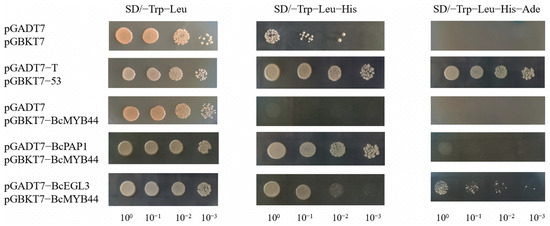
Figure 3.
Y2H results of BcMYB44 and BcPAP1/BcEGL3, pGADT7 + pGBKT7 and pGADT7-T + pGBKT7-53 were the negative and positive control.
In order to further verify the interactions of BcMYB44, we performed a BiFC experiment. From the images we captured, no fluorescence signal was observed in the control groups (BcMYB44-nYFP + 35S-cYFP, 35S-nYFP + BcPAP1-cYFP and 35S-nYFP + BcEGL3-cYFP), while yellow fluorescence signals were detected in BcMYB44-nYFP + BcPAP1-cYFP and BcMYB44-nYFP + BcEGL3-cYFP groups. The location of the fluorescence coincided with the nucleus (Figure 4), indicating that BcMYB44 interacted with BcPAP1 and BcEGL3 in vivo. The results were consistent with the two-hybrid yeast, and further confirmed that there were interactions between BcMYB44 and BcPAP1/BcEGL3.
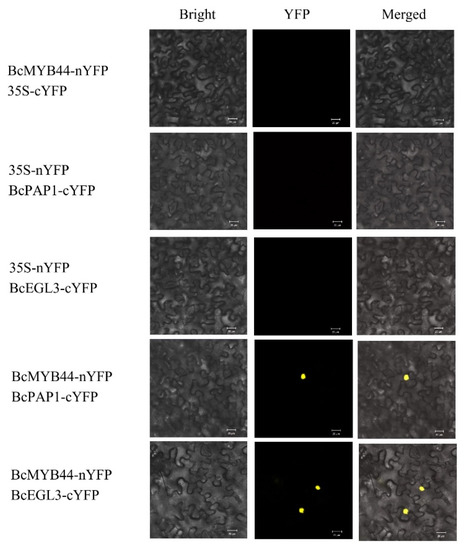
Figure 4.
BiFC verification of BcMYB44 and BcPAP1, BcEGL3. Bright: Bright field; GFP: green fluorescence signal under GFP-excited light; Merged: superposition of GFP and bright field.BcMYB44-nYFP + 35S-cYFP, 35S-nYFP + BcPAP1-cYFP and 35S-nYFP + BcEGL3-cYFP were the control group. Scale bars = 20 µM.
3.4. Pigment Detection of BcPAP1 and BcMYB44 Protein Activity in Anthocyanin Pathway
We transferred the pRI101-BcMYB44 and pRI101-BcPAP1 vectors into Agrobacterium for agroinfiltration, and then injected them into the abaxial side of N. benthamiana leaves. The color change was observed within 10–20 days after the injection (Figure 5). It was found that there was no pigmentation on the surface of N. benthamiana injected with an empty vector (pRI101-S) bacterial solution. Obvious pigmentation on the surface of N. benthamiana leaves injected with an anthocyanin synthesis activator (pRI101-BcPAP1) was observed, while pigmentation was significantly reduced or even not apparent in the leaf which was injected with pRI101-BcPAP1 and pRI101- BcMYB44 together.
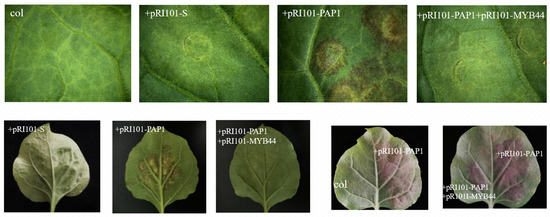
Figure 5.
Transient color determination of BcPAP1 and BcMYB44 protein activity in N. benthamiana. The first row were partial views of N. benthamiana leaves under a microscope, and the second row were whole views of N. benthamiana leaves. (col: blank control; pRI101-S: empty vector control).
We performed a quantitative analysis of key structural genes for anthocyanin synthesis in N. benthamiana. The results showed that the expression levels of key structural genes for anthocyanin synthesis in N. benthamiana injected with pRI101-PAP1 were significantly up-regulated, especially for NtF3H and NtDFR (Figure 6C,D), which, respectively, increased 27.07 times and 10.91 times. Compared with pRI101-BcPAP1 alone, co-injection of pRI101-BcPAP1 and pRI101-BcMYB44 significantly reduced the expression levels of key structural genes for anthocyanin synthesis, among which NtF3H and NtDFR were the most significant. As the injection ratio of pRI101-BcMYB44 increased, the gene down-regulation became more significant. The above results explained that BcMYB44 had a negative regulatory effect on anthocyanin synthesis, possibly by inhibiting the expression of key structural genes for anthocyanin synthesis including F3H, DFR, ANS, CHI, CHS, UFGT and anthocyanin synthesis-activating transcription factor PAP1.
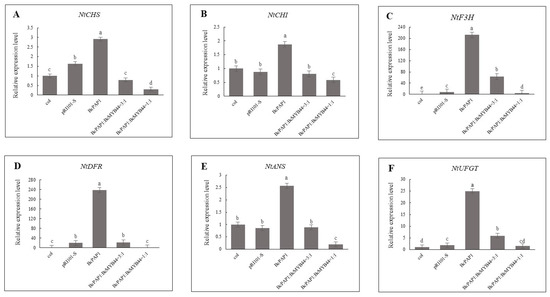
Figure 6.
Relative expression levels of key structural genes for anthocyanin synthesis in N. benthamiana. (A—NtCHS; B—NtCHI; C—NtF3H; D—NtDFR; E—NtANS; F—NtUFGT). Note: Different lowercase letters indicate significant difference (p < 0.05).
3.5. VIGS Analysis of BcMYB44
The TYMV vector was used in this study, which degraded natural pigments. Initial degradation occurred about 14 days after injection of the virus, and gradually spread along the veins and appeared in the new leaves. For the inbred line ‘NJZX1-3’, compared with the WT, the plants transferred into pTY-BcMYB44 or pTY-S were lighter purple and the pTY-S plants faded more obviously. For the green mutant ‘NJZX1-0’, the leaves of the plants appeared mottled after fading. Moreover, the growth of pTY-BcMYB44 plants was worse than that of pTY-S plants (Figure 7). Diseased leaves were collected to detect gene silencing efficiency 21 days after TYMV injection. The silencing efficiency was 77.29% and 70.12%, respectively, (Figure 8A). Total anthocyanin content decreased after morbidity, but compared with pTY-S plants, anthocyanin content in pTY-BcMYB44 plants was significantly higher (Figure 8B), as well as relative enzyme activities (PAL, CHI and UFGT) in the three stages of anthocyanin synthesis (Figure 8C). These results further confirmed the inhibitory effect of BcMYB44 on anthocyanin synthesis and accumulation in non-heading Chinese cabbage.
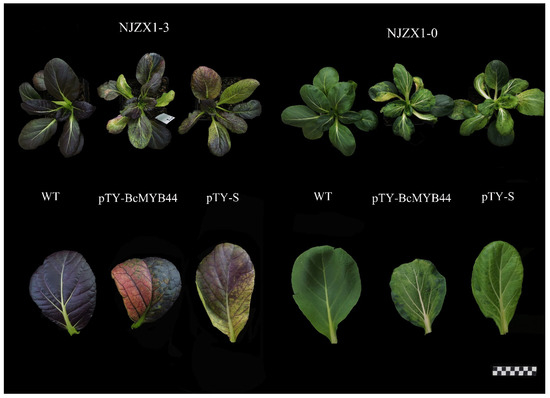
Figure 7.
Phenotypic changes of non-heading Chinese cabbage materials after VIGS treatment. From left to right were WT, pTY-BcMYB44, pTY-S of ‘NJZX1-3’; WT, pTY-BcMYB44, pTY-S of ‘NJZX1-0’ (WT: wild type; pTY-BcMYB44: gene scilencing plant; pTY-S: empty vector plant).

Figure 8.
Changes in BcMYB44 relative expression levels (A), total anthocyanin content (B), and PAL, CHI, UFGT enzyme activities (C) after BcMYB44 silence. Note: Different lowercase letters indicate significant difference (p < 0.05).
3.6. Analysis of Drought Tolerance of Non-Heading Chinese Cabbage Based on VIGS Treatment
VIGS seedlings of ‘NJZX1-3’were subjected to drought treatment and pTY-S was used as the control to explore the regulatory function of BcMYB44 under drought stress. The leaf relative water content of the pTY-S plant decreased by 32.4%, while that of pTY-BcMYB44 plants decreased by 49.7% (Figure 9A). The leaf relative electrical conductivity of pTY-S and pTY-BcMYB44 increased by 461.3% and 587.3%, respectively (Figure 9B). It indicated that drought stress caused deeper damage to pTY-BcMYB44 plants. Figure 9C reflected that the anthocyanin content generally increased first and then decreased, while the control group was always lower and declined faster. Chlorophyll content and the photosynthetic rate decreased, and the pTY-BcMYB44 group was consistently lower than the control group, but not obviously (Figure 9D,E). The stomatal conductance of the pTY-BcMYB44 group decreased less than that of the control group (Figure 9G), which might result in a lower decrease in the transpiration rate than that in the control group (Figure 9F). The changes in the stomatal diameter (Figure 9H) in the non-drought treatment group (CT) and the drought stress group (DS) were consistent with the stomatal conductance (Figure 9G), indicating that BcMYB44 may be involved in the regulation of stomatal movement. These results suggested that the silencing of BcMYB44 decreased the drought tolerance of non-heading Chinese cabbage, which was most likely related to the regulation of stomatal movement and anthocyanin synthesis by BcMYB44.
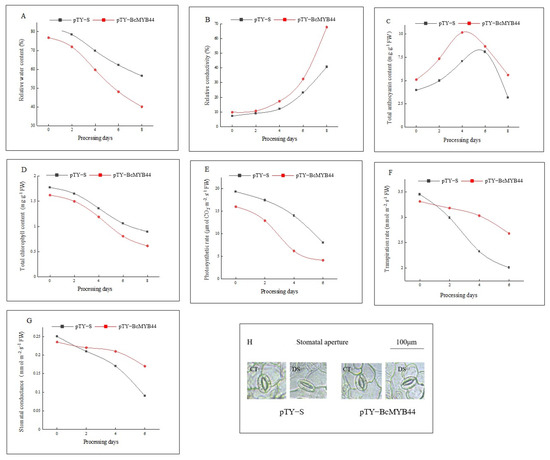
Figure 9.
Physiological indexes of non-heading Chinese cabbage under drought stress. They were in order of relative water content (A), relative conductivity (B), total anthocyanin content (C), chlorophyll content (D), photosynthetic rate (E), transpiration rate (F), stomatal conductance (G) and stomatal aperture (H).
Drought-regulating substances were also measured. The proline content increased by 3.71 times and 6.69 times, respectively (Figure 10A), i.e., the accumulation of the pTY-BcMYB44 group was lower than that of the control. It indicated that the osmotic adjustment ability in the pTY-BcMYB44 group was weaker. The MDA content also increased by 1.18 times and 0.59 times, respectively (Figure 10B), suggesting that the plants in the pTY-BcMYB44 group had a deeper degree of membrane lipid peroxidation and were damaged more seriously (Figure 10C–E). Correspondingly, the activity of SOD, POD, and CAT was significantly increased, among which the pTY-BcMYB44 group was significantly lower, so the antioxidant capacity under drought stress was weaker. The above results showed that BcMYB44 positively regulated the tolerance of non-heading Chinese cabbage under drought stress. In addition to regulating stomatal movement and anthocyanin synthesis, it was also achieved by increasing the ability of osmoregulation and scavenging ROS.
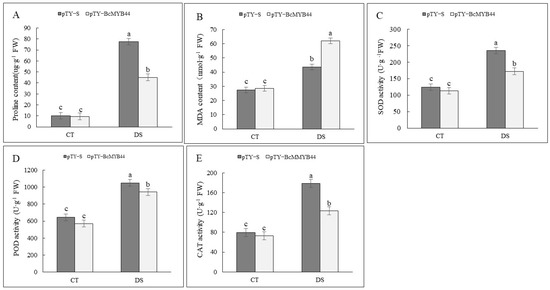
Figure 10.
Changes of some substances in non-heading Chinese cabbage under drought stress, including proline (A), malondialdehyde (B), SOD (C), POD (D), CAT (E) enzyme activity. CT—control, DS—drought stress. Note: Different lowercase letters indicate significant difference (p < 0.05).
4. Discussion
As one of the largest TF families in higher plants, MYB TF involves diverse biological, functional and structural processes [28]. Several studies showed that flavonoid-related R2R3-MYB repressors had been isolated in various plants, such as PqMYB4 [29], AtMYBL2 [30] and PpMYB18 [31]. The study confirmed that BcMYB44 belonged to R2R3-MYB and had the same two MYB domains and transcriptional suppression of the LSLSL subdomain with other closely related MYB44 proteins, which was consistent with the findings of Wei et al. [11]. We also found that BcMYB44 interacted with BcPAP1/BcEGL3, which were known to be involved in the positive regulation of anthocyanin synthesis [21]. Moreover, several potential protein interactions had been reported for their flavonoid biosynthetic components in potatoes [32]. It indicated that the interaction between BcMYB44 and BcPAP1/BcEGL3 might affect the synthesis of anthocyanin in non-heading Chinese cabbage, but it needs to be further explored.
Liu et al. found that StMYB44s in potatoes directly inhibited the activity of the key gene DFR promoter and the possible TFs (StAN1 and StbHLH1) in the anthocyanin pathway [33]. Furthermore, the study in potatoes showed that IbMYB44s might inhibit the formation of the MYB340 (PAP1)-bHLH2-NAC56A/B complex, thus negatively regulating anthocyanin biosynthesis [11]. Our study explored the role of BcMYB44 in anthocyanin synthesis by pigment detection of BcPAP1 and BcMYB44 protein activity in N. benthamiana. We found that BcMYB44 can reduce pigmentation in N. benthamiana leaves caused by BcPAP1. RT-qPCR results showed that the expression levels of the key structural genes for anthocyanin synthesis were significantly up-regulated, especially NtF3H and NtDFR after injection of pRI101-BcPAP1, while co-injection of pRI101-BcPAP1 and pRI101-BcMYB44 significantly reduced the expression levels of these genes. With an increase of the injection ratio of pRI101-BcMYB44, these gene expressions were down-regulated more significantly. It suggested that BcMYB44 played a negative regulatory role by inhibiting the expression of key structural genes of anthocyanin synthesis (CHI, CHS, DFR, F3H, ANS, UFGT) and activating the transcription factor (PAP1). However, the mechanism of BcMYB44 regulating anthocyanin synthesis in non-heading Chinese cabbage still needs to be further explored. Whether it is related to DFR or F3H promoter activity and the formation of PAP1-related complexes remains to be studied.
VIGS of PhLcyB in petunia plants proved that PhLcyB is involved in the regulation of carotenoid synthesis [34]. In our study, VIGS treatment showed that pTY-BcMYB44 plants had a stronger ability to synthesize anthocyanins compared with pTY-S plants. The activity of three key enzymes (PAL, CHI, UFGT) of anthocyanin synthesis in pTY-BcMYB44 plants was higher too. It further indicated that BcMYB44 inhibited anthocyanin synthesis in non-heading Chinese cabbage.
On the other hand, previous studies showed that MYB44 also played a key regulatory role in plant abiotic stress, but it responded to different stress in different plants. BnMYB44 responded to drought and salt stress in Brassica napus. [35]. MdMYB44 was sensitive to cold and salt stress in apple callus [36]. Dominant inhibition of AtMYB44 led to oxidative damage and hypersensitivity to abiotic stress [37]. Li et al. confirmed that XsMYB44 positively regulated tolerance to drought and heat stress on the basis of VIGS [17]. In our study, the VIGS plants of the inbred line ‘NJZX1-3’ were further treated with drought stress. These results showed that pTY-S plants had higher drought tolerance, more significant changes in stomatal aperture and greater increases in osmotic regulatory substances and ROS scavenging enzymes than pTY-BcMYB44 plants. We found that anthocyanin enrichment of pTY-S was weaker in the early stage of treatment, but decreased significantly faster in the later stage. Anthocyanin enrichment had been shown to reduce the drought resistance of plants to some extent [20]. These results indicated that BcMYB44 had a positive regulatory function in drought stress and most likely by inhibiting anthocyanin enrichment, regulating stomatal movement, increasing the ability of osmoregulation and regulating the homeostasis of ROS.
In a nutshell, BcMYB44 played a negative regulatory role in the synthesis of anthocyanins in non-heading Chinese cabbage and a positive regulatory role in drought stress, and there was a certain causality between the two. However, this study lacked transcriptomics analysis such as the study of TIFY protein family [38], so the specific pathways and branches which were affected by the BcMYB44 were unclear and needed to be further explored.
5. Conclusions
In summary, BcMYB44 was cloned from non-heading Chinese cabbage. The sequence was 903 bp and encoded 300 amino acids. Sequence analysis indicated that the BcMYB44 protein belonged to the R2R3-MYB family and was most closely related to the BnMYB44 protein in Brassica napus. This study confirmed BcMYB44 was a nuclear protein and interacted with the anthocyanin synthesis positive transcription factors BcPAP1 and BcEGL3. We also found that BcMYB44 negatively regulated anthocyanin synthesis by inhibiting the expression of key genes (DFR, F3H, etc.). VIGS treatment further confirmed the inhibition and verified that BcMYB44 played a positive regulatory role in drought stress by inhibiting anthocyanin accumulation, regulating stomatal movement, and increasing osmotic regulation and homeostasis of ROS.
Supplementary Materials
The following supporting information can be downloaded at: https://www.mdpi.com/article/10.3390/horticulturae8050351/s1. Table S1: All primer sequences used in this study. Figure S1: Conserved domains of BcMYB44 protein.
Author Contributions
Conceptualization, C.H., Y.H. and Q.Z.; funding acquisition and supervision, J.W. and X.H.; formal analysis, Y.H. and H.M.M.; investigation, Y.H.; writing—original draft preparation, Y.H.; writing—review and editing, Y.H. and C.H. All authors have read and agreed to the published version of the manuscript.
Funding
This research was funded by: North Jiangsu science and technology special project (LYG-SZ201928); National entrepreneurship practice program for college students (201910307092K); Jiangsu innovation and entrepreneurship project (202110307001P).
Institutional Review Board Statement
Not applicable.
Informed Consent Statement
Not applicable.
Data Availability Statement
The authors confirm that the data supporting the findings of this study are available within the article and its Supplementary Materials.
Acknowledgments
We would like to thank the Laboratory of Cabbage Biological Systems, College of Horticulture, Nanjing Agricultural University for the support of materials (‘NJZX1-3’ and ‘NJZX1-0’).
Conflicts of Interest
The authors declare no conflict of interest.
References
- Li, Y.; Liu, G.F.; Ma, L.M.; Liu, T.K.; Zhang, C.W.; Xiao, D.; Zheng, H.K.; Chen, F.; Hou, X.L. A chromosome-level reference genome of non-heading Chinese cabbage [Brassica campestris (syn. Brassica rapa) ssp. chinensis]. Hortic. Res. 2020, 7, 212. [Google Scholar] [CrossRef] [PubMed]
- Hou, X.L.; Li, Y.; Huang, F.Y. The main characters of non-heading Chinese cabbage (Brassica campestris ssp. chinensis) and the new progress of molecular biology research on breeding techniques. Acta Hortic. Sin. 2020, 47, 1663–1677. [Google Scholar]
- Sun, B.; Zhang, F.; Xue, S.L.; Chang, J.Q.; Zhang, A.H.; Jiang, M.; Miao, H.Y.; Wang, Q.M.; Tang, H.R. Molecular Cloning and Expression Analysis of the ζ-Carotene Desaturase Gene in Chinese kale (Brassica oleracea var. alboglabra Bailey). Hortic. Plant J. 2018, 4, 94–102. [Google Scholar] [CrossRef]
- Li, W.X.; Yang, S.B.; He, Z.C.; Jin, B. Research progress in plant leaf color change mechanism. Acta Hortic. Sin. 2017, 44, 1811–1824. [Google Scholar]
- Yang, L.P.; Ling, W.H.; Du, Z.C.; Chen, Y.M.; Li, D.; Deng, S.Z.; Liu, Z.M.; Yang, L.L. Effects of Anthocyanins on Cardiometabolic Health: A Systematic Review and Meta-Analysis of Randomized Controlled Trials. Adv. Nutr. 2017, 8, 684–693. [Google Scholar] [CrossRef]
- Cao, Y.P.; Li, K.; Li, Y.L.; Zhao, X.P.; Wang, L.H. MYB Transcription Factors as Regulators of Secondary Metabolism in Plants. Biology 2020, 9, 61. [Google Scholar] [CrossRef] [Green Version]
- Liu, J.Y.; Osbourn, A.; Ma, P. MYB Transcription Factors as Regulators of Phenylpropanoid Metabolism in Plants. Mol. Plant 2015, 8, 689–708. [Google Scholar] [CrossRef] [Green Version]
- Wang, Y.; Yang, X.; Yang, R.J.; Wang, Y.X.; Yang, F.X. Research progress of MYB transcription factors regulating phenylpropane biosynthesis. J. Anhui Agric. Univ. 2019, 46, 859–864. [Google Scholar]
- Xu, F.; Ning, Y.J.; Zhang, W.W.; Liao, Y.L.; Li, L.L.; Cheng, H.; Cheng, S.Y. An R2R3-MYB transcription factor as a negative regulator of the flavonoid biosynthesis pathway in Ginkgo biloba. Funct. Integr. Genom. 2014, 14, 177–189. [Google Scholar] [CrossRef]
- Yang, W.J. Cloning and Expression of Soybean MYB Transcription Factor Gene; Sichuan Agricultural University: Ya’an, China, 2007. [Google Scholar]
- Wei, Z.Z.; Hu, K.D.; Zhao, D.L.; Tang, J.; Huang, Z.Q.; Jin, P.; Li, Y.H.; Han, Z.; Hu, L.Y.; Yao, G.F.; et al. MYB44 competitively inhibits the formation of the MYB340-bHLH2-NAC56 complex to regulate anthocyanin biosynthesis in purple-fleshed sweet potato. BMC Plant Biol. 2020, 20, 258. [Google Scholar] [CrossRef]
- Wan, D.P. Gene Cloning and Analysis of MYB Transcription Factors of Type V Purple-Spotted White Clover and Tartary BuckWheat; Inner Mongolia Agricultural University: Inner Mongolia, China, 2018. [Google Scholar]
- Seo, P.J.; Xiang, F.; Qiao, M.; Park, J.Y.; Lee, Y.N.; Kim, S.G.; Lee, Y.H.; Park, W.J.; Park, C.M. The MYB96 transcription factor mediates abscisic acid signaling during drought stress response in Arabidopsis. Plant Physiol. 2009, 151, 275–289. [Google Scholar] [CrossRef] [Green Version]
- Feng, C.P.; Andreasson, E.; Maslak, A.; Mock, H.P.; Mattsson, O.; Mundy, J. Arabidopsis MYB68 in development and responses to environmental cues. Plant Sci. 2004, 167, 1099–1107. [Google Scholar] [CrossRef]
- Almeida, T.; Pinto, G.; Correia, B.; Santos, C.; Goncalves, S. QsMYB1 expression is modulated in response to heat and drought stresses and during plant recovery in Quercus suber. Plant Physiol. Biochem. 2013, 73, 274–281. [Google Scholar] [CrossRef]
- Li, Z.Y.; Jiao, Z.X.; Chen, Y.; Gao, F.; Zhou, Y.J. Cloning and expression pattern analysis of Astragalus AmMYB44 gene. Genom. Appl. Biol. 2019, 38, 3605–3613. [Google Scholar]
- Li, J.B.; Zhao, S.; Yu, X.; Du, W.; Li, H.; Sun, Y.; Sun, H.; Ruan, C.J. Role of Xanthoceras sorbifolium MYB44 in tolerance to combined drought and heat stress via modulation of stomatal closure and ROS homeostasis. Plant Physiol. Biochem. 2021, 162, 410–420. [Google Scholar] [CrossRef] [PubMed]
- Chen, Y.P.; Liu, G.N.; Yan, Y.X.; Cao, Z. Effects of drought stress on black rice anthocyanin content and PAL activity. J. Jilin Agric. Sci. Technol. Inst. 2012, 21, 8–10. [Google Scholar]
- Li, Y.F.; Li, Y.H.; Wang, Z.H.; Guan, N.; Feng, C.J.; Yang, J.M. Effects of soil drought stress on the leaf color of purple-leaf dwarf cherry. Acta Ecol. Sin. 2009, 29, 3678–3684. [Google Scholar]
- Xiao, Z. Research on the Functional Differences between Flavonols and Anthocyanins in Plant Stress Resistance; Shandong University: Jinan, China, 2018. [Google Scholar]
- Liu, D.; Zhou, Q.; Kong, X.Y.; Hu, C.M.; Hou, X.L. Cloning and silencing analysis of non-heading Chinese cabbage anthocyanin synthesis transcription factor gene BcEGL3. J. Nanjing Agric. Univ. 2021, 44, 249–258. [Google Scholar]
- Zhu, S.H.; Li, Y.J.; Zhang, X.Y.; Liu, F.; Xue, F.; Zhang, Y.S.; Kong, Z.S.; Zhu, Q.H.; Sun, J. GhAlaRP, a cotton alanine rich protein gene, involves in fiber elongation process. Crop J. 2021, 9, 313–324. [Google Scholar] [CrossRef]
- Janik, K.; Stelmach, H.; Mittelberger, C.; Hause, B. Characterization of Phytoplasmal Effector Protein Interaction with Proteinaceous Plant Host Targets Using Bimolecular Fluorescence Complementation (BiFC). Methods Mol. Biol. 2019, 1875, 177–194. [Google Scholar]
- Hellens, R.P.; Allan, A.C.; Friel, E.N.; Bolitho, K.; Grafton, K.; Templeton, M.D.; Karunairetnam, S.; Gleave, A.P.; Laing, W.A. Transient expression vectors for functional genomics, quantification of promoter activity and RNA silencing in plants. Plant Methods 2005, 1, 13. [Google Scholar] [CrossRef] [Green Version]
- Livak, K.J.; Schmittgen, T.D. Analysis of relative gene expression data using real-time quantitative PCR and the2(-Delta Delta C(T)) method. Methods 2001, 25, 402–408. [Google Scholar] [CrossRef] [PubMed]
- Dong, H.J.; Hou, X.L.; Han, K.; Zhang, Z.S.; Hu, C.M. Cloning and expression analysis of a negative regulatory gene BrcLBD39 for anthocyanin Synthesis and its Response to Exogenous 6-BA in Chinese cabbage. J. Nanjing Agric. Univ. 2018, 41, 49–56. [Google Scholar]
- Huang, C.; Wen, X.; Tang, Y.; Guo, L.Z.; Jiang, S.J.; Dai, Q.L. Effects of exogenous salicylic acid on the physiology of pakchoi seedlings under salt stress. Jiangsu Agric. Sci. 2020, 48, 147–151. [Google Scholar]
- Butt, H.I.; Yang, Z.E.; Gong, Q.; Chen, E.Y.; Wang, X.Q.; Zhao, G.; Ge, X.Y.; Zhang, X.Y.; Li, F.G. GaMYB85, an R2R3 MYB gene, in transgenic Arabidopsis plays an important role in drought tolerance. BMC Plant Biol. 2017, 17, 142. [Google Scholar] [CrossRef]
- Huo, D.; Liu, X.K.; Zhang, Y.; Duan, J.J.; Zhang, Y.L.; Luo, J.R. A Novel R2R3-MYB Transcription Factor PqMYB4 Inhibited Anthocyanin Biosynthesis in Paeonia qiui. Int. J. Mol. Sci. 2020, 21, 5878. [Google Scholar] [CrossRef]
- Matsui, K.; Umemura, Y.; Ohme-Takagi, M. AtMYBL2, a protein with a single MYB domain, acts as a negative regulator of anthocyanin biosynthesis in Arabidopsis. Plant J. Cell Mol. Biol. 2008, 55, 954–967. [Google Scholar] [CrossRef] [PubMed]
- Zhou, H.; Lin, W.K.; Wang, F.; Espley, R.V.; Ren, F.; Zhao, J.; Ogutu, C.; He, H.; Jiang, Q.; Allan, A.C. Activator-type R2R3-MYB genes induce a repressor-type R2R3-MYB gene to balance anthocyanin and proanthocyanidin accumulation. New Phytol. 2019, 221, 1919–1934. [Google Scholar] [CrossRef] [PubMed] [Green Version]
- Faraji, S.; Heidari, P.; Amouei, H.; Filiz, E.; Abdullah; Poczai, P. Investigation and Computational Analysis of the Sulfotransferase (SOT) Gene Family in Potato (Solanum tuberosum): Insights into Sulfur Adjustment for Proper Development and Stimuli Responses. Plants 2021, 10, 2597. [Google Scholar] [CrossRef]
- Liu, Y.H.; Lin, W.K.; Espley Richard, V.; Wang, L.; Li, Y.M.; Liu, Z.; Zhou, P.; Zeng, L.H.; Zhang, X.J.; Zhang, J.L.; et al. StMYB44 negatively regulates anthocyanin biosynthesis at high temperatures in tuber flesh of potato. J. Exp. Bot. 2019, 70, 3809–3824. [Google Scholar] [CrossRef] [Green Version]
- Xu, W.J.; Dubos, C.; Lepiniec, L. Transcriptional control of flavonoid biosynthesis by MYB-bHLH-WDR complexes. Trends Plant Sci. 2015, 20, 176–185. [Google Scholar] [CrossRef] [PubMed]
- Shamloo-Dashtpagerdi, R.; Razi, H.; Ebrahimie, E.; Niazi, A. Molecular characterization of Brassica napus stress related transcription factors, BnMYB44 and BnVIP1, selected based on comparative analysis of Arabidopsis thaliana and Eutrema salsugineum transcriptomes. Mol. Biol. Rep. 2018, 45, 1111–1124. [Google Scholar] [CrossRef] [PubMed]
- Wu, R.G.; Wang, Y.; Wu, T.; Xu, X.F.; Han, Z.H. Functional characterisation of MdMYB44 as a negative regulator in the response to cold and salt stress in apple calli. J. Hortic. Sci. Biotechnol. 2018, 93, 347–355. [Google Scholar] [CrossRef]
- Persak, H.; Pitzschke, A. Dominant repression by Arabidopsis transcription factor MYB44 causes oxidative damage and hypersensitivity to abiotic stress. Int. J. Mol. Sci. 2014, 15, 2517–2537. [Google Scholar] [CrossRef] [PubMed] [Green Version]
- Heidari, P.; Faraji, F.; Ahmadizadeh, M.; Ahmar, S.; Mora-Poblete, F. New Insights into Structure and Function of TIFY Genes in Zea mays and Solanum lycopersicum: A Genome-Wide Comprehensive Analysis. Front. Genet. 2021, 12, 534. [Google Scholar] [CrossRef] [PubMed]
Publisher’s Note: MDPI stays neutral with regard to jurisdictional claims in published maps and institutional affiliations. |
© 2022 by the authors. Licensee MDPI, Basel, Switzerland. This article is an open access article distributed under the terms and conditions of the Creative Commons Attribution (CC BY) license (https://creativecommons.org/licenses/by/4.0/).